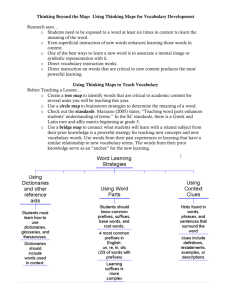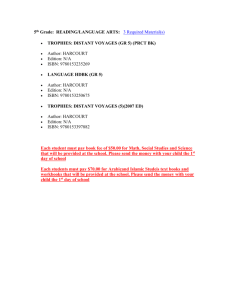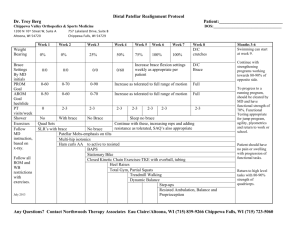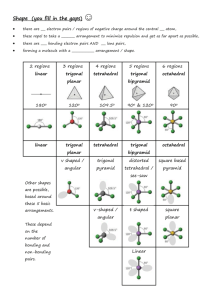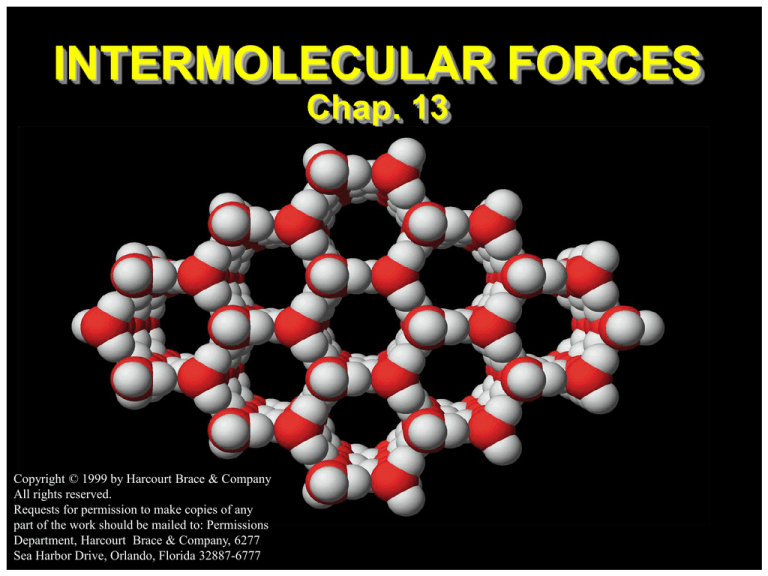
INTERMOLECULAR FORCES
Chap. 13
Copyright © 1999 by Harcourt Brace & Company
All rights reserved.
Requests for permission to make copies of any
part of the work should be mailed to: Permissions
Department, Harcourt Brace & Company, 6277
Copyright (c) 1999 by Harcourt Brace & Company
Sea
Harbor
Drive, Orlando, Florida 32887-6777
All
rights
reserved
Have studied INTRAmolecular
forces—the forces holding
atoms together to form
molecules.
Now turn to forces between
molecules —
INTERmolecular forces.
Forces between molecules,
between ions, or between
molecules and ions.
Table 13.1:
summary of
forces and their relative
strengths.
Copyright (c) 1999 by Harcourt Brace & Company
All rights reserved
Intermolecular
Forces
Intermolecular Forces
Ion-Ion Forces
Na+ — Cl- in salt.
These are the
strongest forces.
Lead to solids with
high melting
temperatures.
NaCl, mp = 800 oC
MgO, mp = 2800 oC
Copyright (c) 1999 by Harcourt Brace & Company
All rights reserved
Attraction Between
Ions and Permanent
Dipoles
••
••
water
-
dipole
O
H
H +
Water is highly polar
and can interact
with positive ions to
give hydrated
ions in water.
Copyright (c) 1999 by Harcourt Brace & Company
All rights reserved
Attraction Between
Ions and
Permanent Dipoles
••
••
water
-
dipole
O
H
H +
Water is highly polar
and can interact
with positive ions to
give hydrated ions
in water.
Copyright (c) 1999 by Harcourt Brace & Company
All rights reserved
Attraction
Between Ions and
Permanent Dipoles
Many metal ions are
hydrated.
It is the reason metal
salts dissolve in
water.
Co(H2O)62+
Copyright (c) 1999 by Harcourt Brace & Company
All rights reserved
Attraction
Between Ions and
Permanent Dipoles
Attraction between ions and dipole depends on
ion charge and ion-dipole distance.
Measured by DH for Mn+ + H2O --> [M(H2O)x]n+
Copyright (c) 1999 by Harcourt Brace & Company
All rights reserved
Attraction
Between Ions and
Permanent Dipoles
Attraction between ions and dipole depends on
ion charge and ion-dipole distance.
Measured by DH for Mn+ + H2O --> [M(H2O)x]n+
- H
O
H
+
•••
Mg2+
-1922 kJ/mol
- H
O
H
+
•••
Na +
•••
Cs+
-405 kJ/mol -263 kJ/mol
See Example 13.1, page 588.
Copyright (c) 1999 by Harcourt Brace & Company
All rights reserved
- H
O
H
+
Dipole-Dipole
Forces
Such forces bind molecules having
permanent dipoles to one another.
C
+
O
-
Copyright (c) 1999 by Harcourt Brace & Company
All rights reserved
C
+
O
-
C
+
O
-
Dipole-Dipole
Forces
Such forces bind molecules having
permanent dipoles to one another.
C
+
O
-
Copyright (c) 1999 by Harcourt Brace & Company
All rights reserved
C
+
O
-
C
+
O
-
Dipole-Dipole
Forces
Influence of dipole-dipole forces is seen in
the boiling points of simple molecules.
Compd
Mol. Wt.
Boil Point
N2
28
-196 oC
CO
28
-192 oC
Br2
160
59 oC
ICl
162
97 oC
Copyright (c) 1999 by Harcourt Brace & Company
All rights reserved
Hydrogen Bonding
A special form of dipole-dipole attraction,
which enhances dipole-dipole attractions.
Hydrogen bonding in HF
Copyright (c) 1999 by Harcourt Brace & Company
All rights reserved
Hydrogen Bonding
A special form of dipole-dipole attraction,
which enhances dipole-dipole attractions.
H-bonding is strongest when X and Y are
N, O, or F
Copyright (c) 1999 by Harcourt Brace & Company
All rights reserved
FORCES INVOLVING INDUCED
DIPOLES
• How can non-polar molecules such as Br2, I2,
and N2 condense to form liquids and solids?
• Consider I2 dissolving in alcohol, CH3CH2OH.
I-I
ROH dipole
distorts or
polarizes the
I2 electron
cloud
- O
R
H
+
Copyright (c) 1999 by Harcourt Brace & Company
All rights reserved
-
I-I
+
- O
R
H
+
The alcohol
temporarily
creates or
INDUCES a
dipole in I2.
FORCES INVOLVING INDUCED
DIPOLES
• How can non-polar molecules such as Br2, I2,
and N2 condense to form liquids and solids?
• Consider I2 dissolving in alcohol, CH3CH2OH.
Copyright (c) 1999 by Harcourt Brace & Company
All rights reserved
FORCES INVOLVING INDUCED
DIPOLES
Water induces a dipole in nonpolar O2
molecules, and so O2 can dissolve in water.
Copyright (c) 1999 by Harcourt Brace & Company
All rights reserved
FORCES INVOLVING INDUCED
DIPOLES
Formation of a dipole in two nonpolar I2
molecules.
Copyright (c) 1999 by Harcourt Brace & Company
All rights reserved
FORCES INVOLVING INDUCED
DIPOLES
The induced forces between I2 molecules are
very weak, so solid I2 sublimes (goes from a
solid to gaseous molecules).
Copyright (c) 1999 by Harcourt Brace & Company
All rights reserved
FORCES INVOLVING INDUCED
DIPOLES
The size of the dipole depends on the
tendency to be distorted.
Higher molec. weight ---> larger induced
dipoles.
Molecule
Boiling Point (oC)
CH4 (methane)
- 161.5
C2H6 (ethane)
- 88.6
C3H8 (propane)
- 42.1
C4H10 (butane)
- 0.5
Copyright (c) 1999 by Harcourt Brace & Company
All rights reserved


